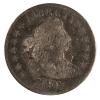You are here
Numismatic Illustrations
Nineteenth-century publications of American coinage of the Revolutionary period display some of the earliest examples of innovative techniques of book illustration.
|
Jacob R. Eckfeldt (1803–1872) and William E. Du Bois (1810–1881). A Manual of Gold and Silver Coins of All Nations. Philadelphia: The Assay Office of the Mint, 1842. Eckfeldt and Du Bois were assayers at the Philadelphia Mint. They illustrated their book with plates engraved with medal-ruling, a mechanical technique of copying relief directly from the coin into the copper plate. They credited the invention of the technique of copying to Christian Gobrecht (1785–1844), the Engraver of the Mint, and its adaptation to reproduce the relief in two dimensions to Joseph Saxton (1799–1873), Constructor and Curator of the standard weighing apparatus of the Mint. To avoid damaging the coins in the process, copies were made using an electrotype process, recently invented by Moritz von Jacobi (1801–1874) in 1838. The frontispiece of the book is a view of the façade of the Mint building engraved from a daguerreotype, an early example of the indirect use of photography in book illustration. |
|
James Ross Snowden (1809–1878). A Description of Medals of Washington. Philadelphia: Lippincott, 1861. The frontispiece and plates of this book were illustrated using the process of anaglyptography, a refinement on the medal-ruling technique developed by the banknote engraver James W. Steel (1799-1879). |
|
Sylvester Sage Crosby (d. 1914). The Early Coins of America. Boston: Estes and Lauriat, 1878. The plates for this important book, for a century the definitive account of early United States coinage, were made using the heliotype process, derived in 1871 from the French collotype process. For a heliotype illustration, a glass plate covered in gelatin was exposed to a photographic negative; ink was then applied which adhered in proportion to the darkness of the image. This process had the advantage over plates produced with lithography or dot screening in that it reproduced halftones continuously; it was used for some numismatic publications until about 1980. |
|
Edward Frossard (1837–1899). Monograph of United States Cents and Half Cents. Irvington, N.Y.: Author, 1879. The illustrations for this work, printed only a year after Crosby’s, were made using a screen to reproduce shading or halftones, which has the disadvantage for serious numismatic research in that the images break down into a sea of dots under magnification. Because of the relative cheapness of this method, however, it came to dominate numismatic as well as most other forms of book illustration through the present day. |
Case Group 8A
|
|
|
|
|
|
|
|
|
|
|
|
|
|
|
|
|
|
|
|
|
|
|
|
|
|
|
|
|
|



























